
In today’s competitive talent market, the difference between attracting top-tier candidates and settling for mediocre hires often comes down to one crucial document: the job description. Yet surprisingly, many organizations still rely on outdated, generic templates that fail to capture the essence of their roles or the excitement of joining their teams. At ResumeKraft.com, we understand that crafting compelling job descriptions is both an art and a science—one that can make or break your recruitment efforts.
Whether you’re a startup founder wearing multiple hats, an HR professional managing high-volume hiring, or a department manager seeking that perfect addition to your team, having the right job description template is essential. This comprehensive guide provides you with six professionally designed templates, each tailored to different industries and hiring scenarios, along with expert tips to transform your job postings from mundane lists of requirements into magnetic opportunities that top talent can’t resist.
- Why Job Description Templates Matter More Than Ever
- 6 Professional Job Description Templates
- 12 Expert Tips for Writing Winning Job Descriptions
- Leveraging Technology in Job Description Creation
- Common Job Description Mistakes to Avoid
- Industry-Specific Considerations
- Measuring Job Description Effectiveness
- Creating Your Job Description Strategy
- The Future of Job Descriptions
- Putting It All Together: Your Action Plan
- Resources for Continued Success
- Conclusion: Your Competitive Advantage Awaits
Why Job Description Templates Matter More Than Ever
The modern job market has fundamentally shifted. With unemployment at historic lows in many sectors and skilled professionals enjoying multiple options, companies must work harder than ever to stand out. Your job description often serves as the first touchpoint between your organization and potential employees—making it a critical component of your employer brand.
The Hidden Costs of Poor Job Descriptions
Inadequate job descriptions create ripple effects throughout your organization:
Misaligned Expectations: Vague or inaccurate descriptions lead to hiring mismatches, resulting in early turnover and wasted resources. When new hires discover the role differs significantly from what was advertised, engagement plummets and resignation letters follow.
Extended Time-to-Fill: Generic postings attract unqualified candidates, forcing recruiters to sift through irrelevant applications. This extends hiring timelines, leaving critical positions vacant and teams overwhelmed.
Reduced Quality of Hire: Without clear requirements and compelling content, you miss out on passive candidates who might be perfect for the role but need convincing to make a move.
Legal Vulnerabilities: Poorly written descriptions can inadvertently include discriminatory language or fail to meet compliance requirements, exposing organizations to legal risks.
The Strategic Advantage of Excellence
Conversely, well-crafted job descriptions deliver measurable benefits:
- Attract Better Candidates: Clear, engaging descriptions draw qualified professionals who understand and want the role
- Improve Conversion Rates: Compelling content increases the percentage of viewers who complete applications
- Enhance Employer Brand: Professional descriptions reflect positively on your organization’s attention to detail
- Streamline Screening: Precise requirements enable faster, more accurate candidate evaluation
- Support Performance Management: Clear expectations established during hiring create foundation for future reviews
6 Professional Job Description Templates
We’ve developed six versatile templates to cover the most common hiring scenarios. Each template balances structure with flexibility, allowing you to maintain consistency while customizing for specific roles.
1. Intern Job Description Template
Perfect for attracting ambitious students and recent graduates, this template emphasizes learning opportunities while setting clear expectations for entry-level contributions.
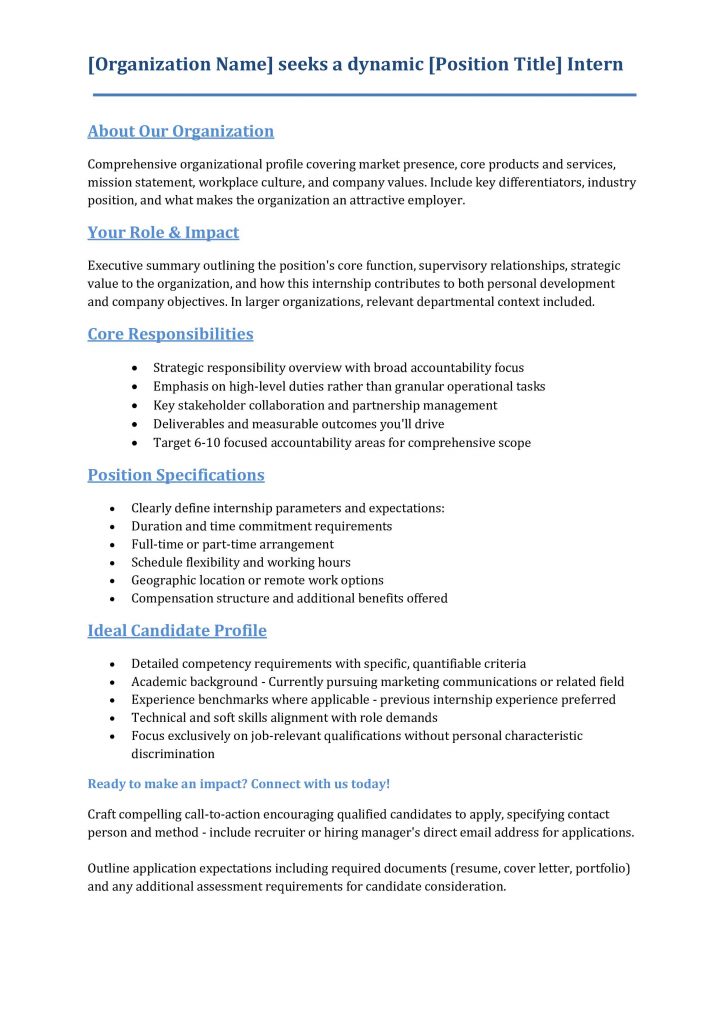
Key Features:
- Vibrant, Youthful Design: Bold colors and modern layout appeal to younger candidates
- Learning-Focused Language: Emphasizes mentorship, skill development, and career growth
- Clear Program Structure: Outlines duration, departments, and potential for full-time conversion
- Flexible Requirements Section: Easily adjusted for different academic levels and majors
- Project Highlights: Space to showcase exciting initiatives interns will contribute to
Best Used For:
- Summer internship programs
- Co-op positions
- Graduate rotational programs
- Entry-level trainee roles
- Student work-study positions
Template Highlights: The intern template recognizes that you’re not just filling a temporary position—you’re potentially recruiting your future full-time employees. It balances the need to attract eager learners with the reality that interns should contribute meaningful work. The design uses energetic colors and clear sections that make it easy for students to quickly identify key information like duration, compensation, and learning opportunities.
2. Basic Job Description Template
The Swiss Army knife of job templates—simple, professional, and universally applicable across industries and roles.
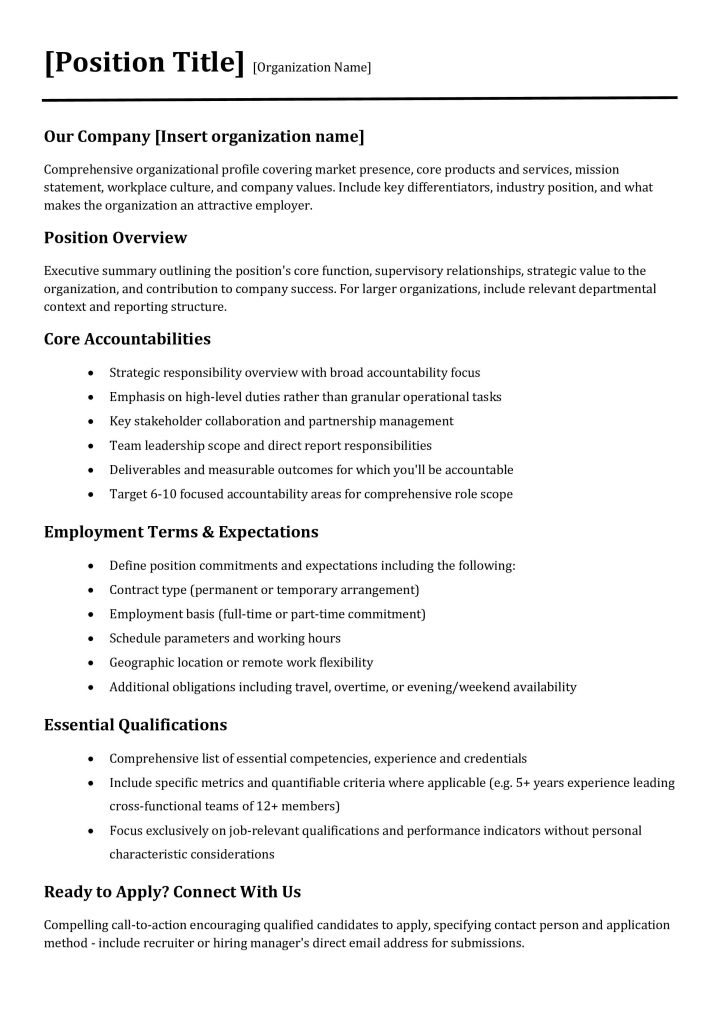
Key Features:
- Clean, Neutral Design: Professional appearance suitable for any company or industry
- Modular Structure: Easy to add, remove, or reorganize sections based on needs
- ATS-Friendly Format: Simple formatting ensures compatibility with applicant tracking systems
- Comprehensive Yet Concise: Includes all essential elements without overwhelming readers
- Universal Language: Professional tone works for technical and non-technical roles alike
Best Used For:
- Small businesses without dedicated HR teams
- Standardizing descriptions across departments
- Contract or temporary positions
- Roles requiring quick turnaround
- Companies preferring minimalist branding
Template Highlights: This template proves that simple doesn’t mean boring. Its strength lies in clarity and adaptability—you can transform it from a retail position to a software engineering role with minimal adjustments. The neutral design ensures your company culture and role specifics take center stage rather than competing with flashy graphics.
3. Professional Job Description Template
Designed for knowledge workers and service professionals, this template strikes the perfect balance between approachability and corporate credibility.
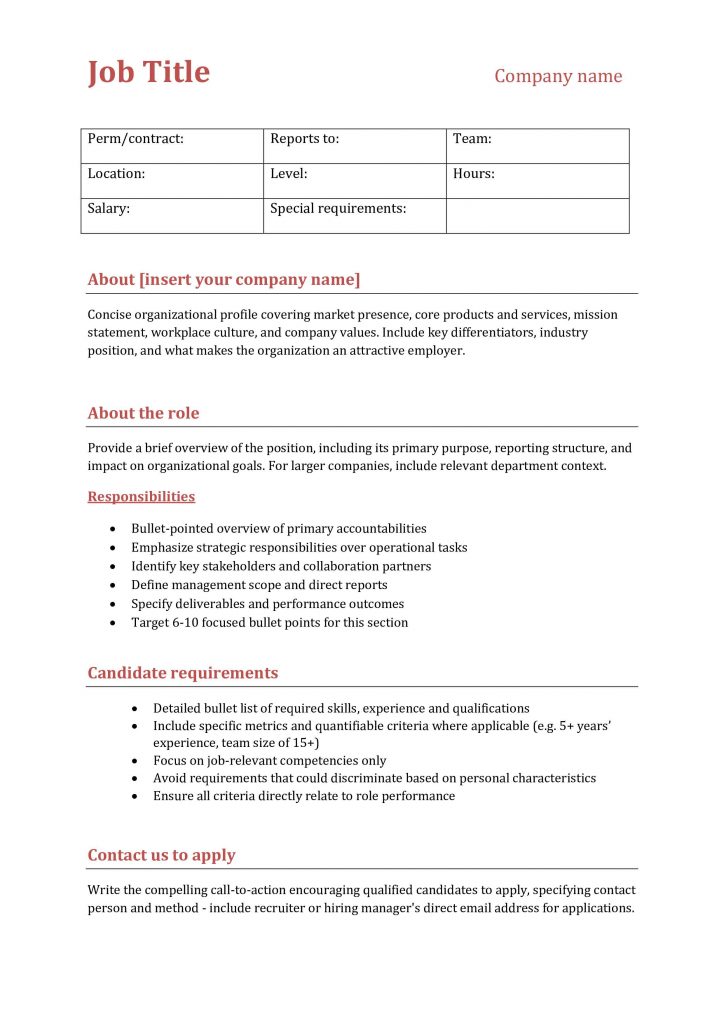
Key Features:
- Vibrant Yet Professional Design: Eye-catching colors maintain business appropriateness
- Prominent Company Information Table: Highlights key organizational details upfront
- Achievement-Oriented Language: Focuses on impact and growth opportunities
- Detailed Benefits Section: Space to showcase comprehensive compensation packages
- Industry-Agnostic Structure: Works across consulting, finance, marketing, and more
Best Used For:
- Professional services firms
- Mid to senior-level positions
- Client-facing roles
- Positions requiring advanced degrees
- Competitive industries where benefits matter
Template Highlights: The professional template recognizes that experienced candidates evaluate opportunities holistically. Beyond just listing responsibilities, it provides framework for communicating career trajectory, organizational impact, and the full value proposition of joining your team. The design uses color strategically to guide readers through sections while maintaining the polished appearance expected in professional settings.
4. Modern Job Description Template
Contemporary and visually striking, this template appeals to forward-thinking organizations and candidates who value innovation.
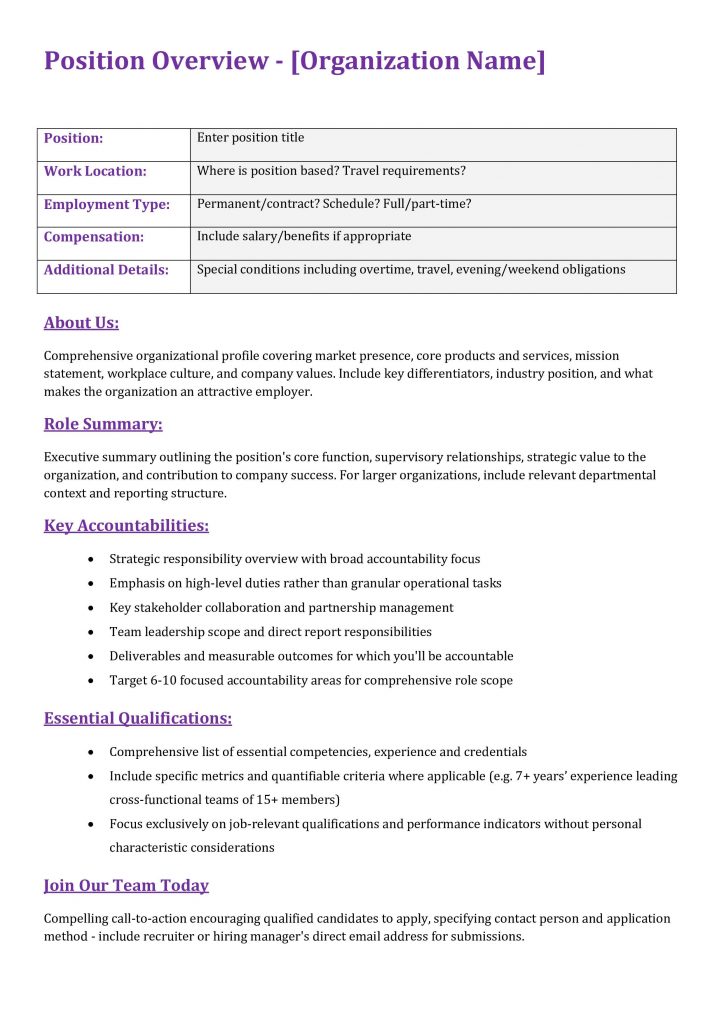
Key Features:
- Split-Page Design: Unique layout improves readability and visual appeal
- Bold Color Accents: Strategic use of color highlights key information
- Plenty of White Space: Clean design prevents information overload
- Flexible Section Options: Easily incorporate company values, perks, or team descriptions
- Mobile-Optimized Layout: Looks great on all devices where candidates might view it
Best Used For:
- Creative industries and agencies
- Startups and scale-ups
- Marketing and design roles
- Companies with strong visual brands
- Positions targeting millennials and Gen Z
Template Highlights: This template breaks from traditional job description conventions while maintaining professionalism. The split-page design naturally guides readers through information hierarchy, while generous white space ensures the content doesn’t feel overwhelming. It’s particularly effective for organizations wanting to communicate innovation and creativity from the first interaction.
5. Corporate Job Description Template
Classic and authoritative, this template conveys stability and professionalism expected by traditional organizations.
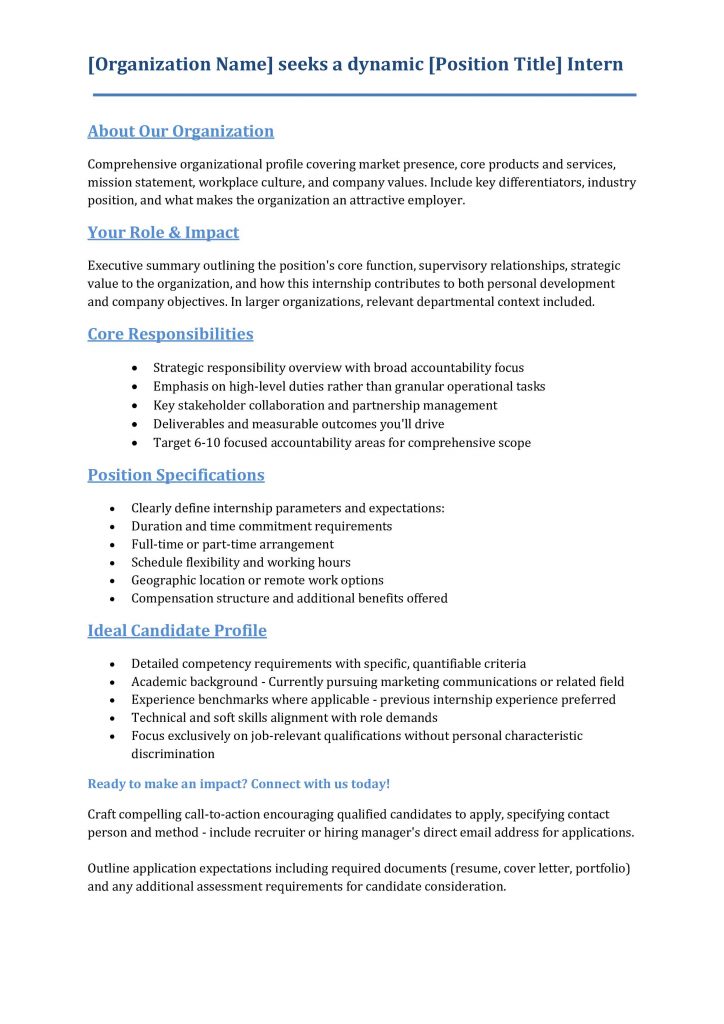
Key Features:
- Traditional Corporate Aesthetic: Understated design emphasizes content over flash
- Formal Structure: Follows conventional job description hierarchy
- Comprehensive Sections: Includes space for detailed requirements and qualifications
- Conservative Color Palette: Professional blues and grays maintain corporate image
- Detailed Formatting Options: Supports complex organizational structures and reporting lines
Best Used For:
- Fortune 500 companies
- Financial institutions
- Government positions
- Healthcare organizations
- Traditional industries like manufacturing or insurance
Template Highlights: The corporate template respects established business conventions while incorporating modern best practices. It provides the formal structure expected in traditional industries while remaining readable and engaging. This template particularly excels at conveying complex organizational hierarchies and detailed requirement lists without becoming unwieldy.
6. Tech Firm Job Description Template
Designed specifically for technology companies, this template speaks the language of developers, engineers, and tech professionals.
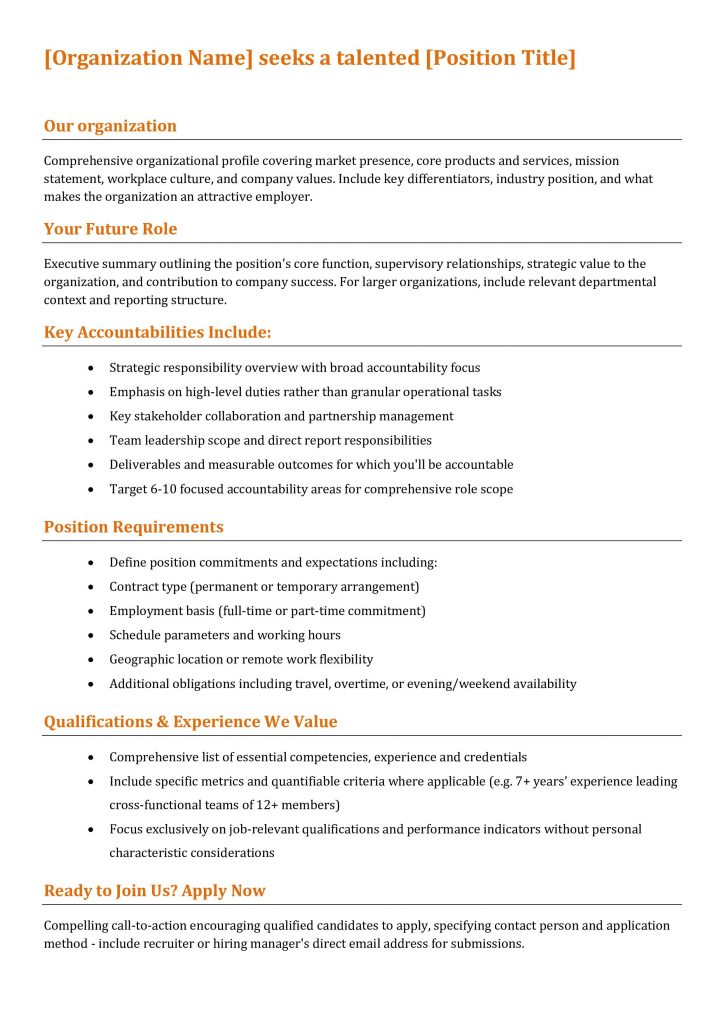
Key Features:
- Modern Tech Aesthetic: Design reflects cutting-edge technology culture
- Casual, Direct Language: Tone resonates with tech professionals
- Technical Skills Prominence: Dedicated sections for languages, frameworks, and tools
- Culture-Forward Approach: Emphasizes team dynamics and work environment
- Project Showcase Areas: Highlight exciting technical challenges and innovations
Best Used For:
- Software companies and startups
- Engineering positions
- Data science and analytics roles
- IT departments in any industry
- Technical positions requiring specific skills
Template Highlights: Tech professionals often evaluate opportunities differently than other candidates. This template accommodates their priorities—interesting technical challenges, modern tech stacks, and collaborative cultures. The casual tone and modern design signal that your organization values innovation and eschews unnecessary formality, while still maintaining professionalism.
12 Expert Tips for Writing Winning Job Descriptions
Having the right template is just the beginning. These proven strategies will help you create job descriptions that attract exceptional candidates and support successful hiring outcomes.
1. Master the Art of Structure and Format
Organization isn’t just about aesthetics—it directly impacts candidate engagement and application rates. A well-structured job description guides readers naturally through information, making it easy to understand the role and evaluate fit.
Essential Structure Elements:
- Job Title: Large, prominent placement at the top
- Company Overview: Brief but compelling organizational introduction
- Role Summary: 3-4 sentences capturing the position’s essence
- Key Responsibilities: 6-10 bullet points outlining core duties
- Requirements: Clear distinction between essential and preferred qualifications
- Benefits and Perks: What makes your offer compelling
- Application Instructions: Clear next steps with contact information
The key is maintaining consistency across all job postings while allowing flexibility for role-specific information. Using our resume templates as inspiration, you can create visually appealing descriptions that stand out in job boards while remaining professional and readable.
2. Optimize Your Job Title for Maximum Visibility
Your job title serves dual purposes: accurately representing the role while maximizing search visibility. The most brilliant job description won’t matter if qualified candidates never find it.
Title Optimization Best Practices:
- Research common search terms using tools like Google Keyword Planner
- Avoid creative titles that sacrifice searchability (“Marketing Ninja” vs. “Digital Marketing Manager”)
- Include seniority level when relevant (Senior, Junior, Lead)
- Add key specializations that candidates search for
- Keep titles under 60 characters for optimal display
Remember that candidates often search for variations of titles. A “Software Engineer” might also search for “Software Developer” or “Programmer.” Understanding these patterns helps you choose titles that capture the widest qualified audience.
3. Sell Your Organization Without Overselling
Today’s candidates research employers as thoroughly as employers screen candidates. Your company description should provide authentic insight into your culture and values while highlighting what makes you an employer of choice.
Effective Company Descriptions Include:
- Clear mission and value proposition
- Recent achievements or recognition
- Team size and structure
- Growth trajectory and stability indicators
- Unique cultural elements or perks
- Commitment to diversity and inclusion
Avoid generic statements like “we work hard and play hard.” Instead, provide specific examples: “Our flexible work policy let 87% of employees achieve better work-life balance last year.” Authenticity builds trust and attracts candidates who align with your actual culture.
4. Write in Clear, Accessible Language
Technical accuracy shouldn’t come at the expense of clarity. While industry-specific terms are necessary, overloading descriptions with jargon alienates qualified candidates who might use different terminology.
Language Best Practices:
- Define acronyms on first use
- Avoid unnecessarily complex words
- Use active voice for energy and clarity
- Break complex requirements into simple points
- Test readability with team members outside the department
Consider your audience’s diversity. A software engineering role might attract candidates from various backgrounds—bootcamp graduates, self-taught programmers, and computer science majors may all be qualified but use different terminology.
5. Speak Directly to Your Ideal Candidate
Effective job descriptions create connection by addressing candidates’ aspirations and concerns directly. This requires understanding your target audience beyond just their technical qualifications.
Creating Candidate Personas:
- What motivates them professionally?
- What are their career advancement goals?
- What concerns might prevent them from applying?
- What competing opportunities are they considering?
- How do they prefer to work and communicate?
Write as if having a conversation with this ideal candidate. Use “you” language: “You’ll lead a team of five engineers” rather than “The successful candidate will lead a team.” This simple shift creates engagement and helps candidates envision themselves in the role.
6. Craft a Compelling Role Overview
Your role summary serves as the elevator pitch—if candidates read nothing else, this section should convince qualified individuals to continue. In 3-4 sentences, capture the role’s essence, impact, and opportunity.
Effective Summaries Answer:
- What is the role’s primary purpose?
- How does it impact the organization?
- Who does the role interact with?
- What makes this opportunity unique?
- Why should someone be excited about this position?
Example: “As our Senior Data Analyst, you’ll transform raw data into insights that drive million-dollar decisions. Working directly with C-suite executives, you’ll influence strategy across our 500-person organization while building advanced analytics capabilities that position us as industry leaders. This role offers unprecedented visibility and the chance to establish our data function from the ground up.”
7. Balance Comprehensive with Concise Responsibilities
The responsibilities section must provide enough detail for candidates to understand daily activities while avoiding overwhelming lists that discourage applications.
Responsibility Writing Formula:
- Start with strong action verbs (develop, lead, analyze)
- Include context about scope or impact
- Focus on outcomes rather than just activities
- Prioritize responsibilities by importance
- Group related tasks together
Instead of: “Responsible for marketing campaigns” Write: “Develop and execute integrated marketing campaigns that drive 30% of company revenue, collaborating with sales and product teams to ensure message consistency across channels”
8. Set Realistic Requirements Without Limiting Diversity
Research shows that underrepresented candidates often don’t apply unless they meet 100% of listed requirements, while others apply meeting just 60%. This self-selection can limit diversity and exclude qualified candidates.
Requirement Strategies:
- Clearly separate “must-haves” from “nice-to-haves”
- Focus on skills that can’t be quickly learned
- Consider equivalent experience alongside formal education
- Avoid years of experience requirements unless truly necessary
- Include “or equivalent” language for certifications
Our AI Resume Builder helps candidates highlight transferable skills—your job descriptions should welcome these non-traditional backgrounds when appropriate.
9. Leverage Internal Expertise
No one understands a role better than those currently doing it or working alongside it. Tap into this knowledge to create accurate, compelling descriptions.
Key Questions for Current Team Members:
- What do you wish you’d known before starting?
- What skills are most critical for success?
- What makes someone excel versus just survive?
- What are the biggest challenges in this role?
- What type of person thrives in our environment?
These conversations often reveal crucial information overlooked in standard descriptions—like the need for patience during the busy season or the importance of cross-functional communication skills.
10. Design for Skimmability
Candidates often review dozens of postings in a session. Your description must communicate key information quickly while providing depth for those wanting details.
Skimmability Techniques:
- Use headers to break up sections
- Employ bullet points for lists
- Bold key information like must-have skills
- Keep paragraphs to 3-4 sentences maximum
- Include white space to prevent wall-of-text syndrome
- Use consistent formatting throughout
Test your description by having someone skim it for 30 seconds. Can they understand the role, requirements, and how to apply? If not, further refinement is needed.
11. Ensure Legal Compliance and Inclusivity
Beyond avoiding obvious discrimination, modern job descriptions must actively promote inclusivity and comply with evolving regulations.
Compliance Checklist:
- Avoid age indicators (“recent graduate,” “digital native”)
- Use gender-neutral language throughout
- Don’t require physical abilities unless essential
- Include equal opportunity employer statement
- Accommodate various backgrounds and experiences
- Avoid cultural biases in requirements
Tools like Textio or Gender Decoder can help identify biased language you might miss. Remember that inclusive job descriptions don’t just avoid lawsuits—they expand your talent pool and strengthen your employer brand.
12. Create Compelling Calls-to-Action
Your call-to-action transforms interested readers into actual applicants. Make applying as frictionless as possible while maintaining necessary screening.
Effective CTA Elements:
- Clear application instructions
- Specific contact person or team
- Expected response timeline
- Required application materials
- Encouragement to apply even if not 100% qualified
- Deadline if applicable
Example: “Ready to revolutionize how millions shop online? Send your resume and a brief note about why you’re excited about this role to careers@company.com. We review applications weekly and aim to respond within 5 business days. Don’t meet every requirement? Apply anyway—we value potential as much as experience!”
Leveraging Technology in Job Description Creation
Modern recruitment technology offers powerful tools to enhance your job descriptions and improve hiring outcomes.
AI-Powered Optimization
Artificial intelligence can analyze successful job postings in your industry, suggesting improvements to language, structure, and requirements. However, AI should enhance rather than replace human judgment—use it to identify opportunities, then apply your organizational knowledge to refine suggestions.
Analytics and Testing
Track metrics like view-to-apply conversion rates, quality of applicants, and time-to-fill across different description versions. This data-driven approach helps continuously improve your recruitment marketing.
Integration with Your Careers Page
Ensure job descriptions align with your broader employer brand. Candidates often research multiple touchpoints—your descriptions should consistent with career site messaging, employee testimonials, and social media presence.
Common Job Description Mistakes to Avoid
Learning from common errors helps create more effective postings from the start.
The Kitchen Sink Syndrome
Including every possible responsibility and requirement creates unwieldy descriptions that discourage strong candidates. Focus on core elements that truly differentiate successful performers.
Copy-Paste Complacency
Reusing old descriptions without updates misses opportunities to reflect role evolution and market changes. Regular reviews ensure descriptions remain accurate and competitive.
Ignoring Mobile Optimization
With over 60% of job seekers using mobile devices, descriptions must be easily readable on small screens. Test your formatted descriptions on various devices before posting.
Forgetting the Human Element
While incorporating keywords for ATS optimization is important, writing solely for algorithms creates robotic descriptions that fail to engage human readers. Balance is key.
Industry-Specific Considerations
Different sectors have unique conventions and expectations that should inform your job descriptions.
Technology Sector
Tech professionals expect details about:
- Specific technologies and frameworks used
- Development methodologies (Agile, Scrum)
- Team structure and collaboration styles
- Innovation opportunities and technical challenges
- Remote work policies and flexibility
Healthcare
Healthcare descriptions must address:
- Required licensures and certifications
- Shift patterns and on-call requirements
- Patient population and specialties
- Technology systems used
- Continuing education opportunities
Retail and Hospitality
Service-oriented roles benefit from including:
- Customer interaction expectations
- Physical requirements honestly stated
- Scheduling flexibility or requirements
- Advancement opportunities within the organization
- Team culture and support systems
Professional Services
Knowledge workers evaluate:
- Client types and industries served
- Travel requirements and work-life balance
- Professional development support
- Partnership or advancement tracks
- Thought leadership opportunities
Measuring Job Description Effectiveness
Creating great job descriptions is an iterative process requiring ongoing measurement and refinement.
Key Performance Indicators
Track these metrics to evaluate success:
- Application Quantity: Are you receiving sufficient applications?
- Application Quality: What percentage meet minimum requirements?
- Conversion Rate: How many viewers become applicants?
- Time-to-Fill: Are positions being filled within target timeframes?
- New Hire Performance: Do hires meet expectations set in descriptions?
- Retention Rates: Are new hires staying beyond initial periods?
Gathering Feedback
Regularly collect input from:
- New hires about description accuracy
- Candidates about clarity and appeal
- Hiring managers about applicant quality
- Recruiters about screening efficiency
- Departing employees about expectation alignment
Continuous Improvement
Use insights to refine your approach:
- A/B test different versions
- Update based on market changes
- Incorporate successful elements across postings
- Retire ineffective language or requirements
- Adapt to changing candidate preferences
Creating Your Job Description Strategy
Successful recruitment requires more than individual good job descriptions—it demands a cohesive strategy aligning all postings with organizational goals.
Establishing Standards
Create guidelines ensuring consistency:
- Brand voice and tone guidelines
- Required sections and formatting
- Approval processes and stakeholders
- Update schedules and ownership
- Compliance requirements and checks
Building Template Libraries
Develop template variations for:
- Different seniority levels
- Various departments or functions
- Contract versus permanent roles
- Remote versus on-site positions
- High-volume versus specialized hiring
Training and Enablement
Equip hiring managers with skills to create effective descriptions:
- Workshop on writing compelling content
- Share successful examples and case studies
- Provide editing and feedback support
- Create quick reference guides
- Establish peer review processes
The Future of Job Descriptions
As work evolves, so too must our approach to describing opportunities. Several trends shape the future of job descriptions:
Skills-Based Hiring
Moving beyond traditional requirements to focus on demonstrable skills opens opportunities for non-traditional candidates while improving hiring outcomes. Future descriptions may include skills assessments or portfolio requirements rather than degree mandates.
Video Job Descriptions
Some organizations supplement written descriptions with video content featuring team members and workplace tours. This multimedia approach appeals to candidates who prefer visual content and provides authentic cultural insights.
Dynamic Personalization
Advanced platforms increasingly personalize job descriptions based on candidate profiles, emphasizing most relevant aspects for each viewer. While maintaining core accuracy, these systems optimize presentation for individual engagement.
Continuous Evolution
Rather than static documents, future job descriptions may evolve based on real-time market data, automatically adjusting requirements or compensation ranges to maintain competitiveness.
Putting It All Together: Your Action Plan
Armed with templates and best practices, follow this systematic approach to transform your job descriptions:
- Audit Current Descriptions: Evaluate existing postings against best practices
- Select Appropriate Templates: Choose templates matching your roles and culture
- Gather Stakeholder Input: Interview team members and hiring managers
- Draft Initial Versions: Create descriptions following guidelines
- Review and Refine: Conduct legal and brand compliance checks
- Test and Iterate: Monitor performance and gather feedback
- Scale Success: Apply learnings across all postings
Remember that great job descriptions are living documents. Regular updates ensure they remain accurate, compelling, and effective at attracting top talent.
Resources for Continued Success
Creating exceptional job descriptions is just one piece of the recruitment puzzle. ResumeKraft.com offers comprehensive resources to support your entire hiring process:
For Writing Better Descriptions: Our resume examples showcase how candidates present their experiences, helping you understand what resonates and how to speak their language in your postings.
For Understanding Candidate Perspectives: Reviewing cover letters reveals what motivates candidates and what information they seek in job postings, enabling you to address these needs proactively.
For Staying Current: Our AI Resume Builder incorporates latest trends in how candidates present themselves, insights that can inform how you structure requirements and desired qualifications.
For Consistency: Just as our resume templates provide consistent, professional formatting for candidates, your job description templates ensure every posting represents your organization professionally.
Conclusion: Your Competitive Advantage Awaits
In the war for talent, your job descriptions serve as powerful weapons—when crafted correctly. The templates and strategies provided here give you everything needed to transform mundane job postings into compelling invitations that attract exceptional candidates.
Remember that behind every job description lies a human story—someone seeking their next opportunity, hoping to find an organization where they can contribute, grow, and thrive. By investing time and effort into creating outstanding job descriptions, you’re not just filling positions; you’re building the foundation of your organization’s future success.
The difference between good and great organizations often comes down to the people they attract and retain. Let your job descriptions be the beacon that draws the best and brightest to your team. Start with our templates, apply these proven strategies, and watch as the quality of your candidate pool transforms.
Your next great hire is out there, waiting to discover the opportunity you’re offering. Make sure your job description does justice to the role, your organization, and the potential that awaits the right candidate. Because in today’s competitive landscape, excellence in recruitment starts with excellence in communication—and that journey begins with your job description.

